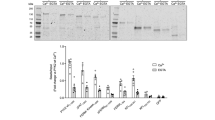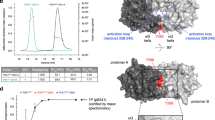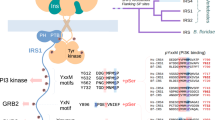Abstract
The APS, SH2-B and LNK proteins are adapters that activate and modulate receptor tyrosine kinase and JAK/STAT signaling. We now show that a conserved N-terminal domain mediates APS homodimerization. We determined the crystal structure of the dimerization domain at a resolution of 1.7 Å using bromide ion MAD phasing. Each molecule contributes two helices to a compact four-helix bundle having a bisecting-U topology. Its most conspicuous feature is a stack of interdigitated phenylalanine side chains at the domain core. These residues create a new motif we refer to as a 'phenylalanine zipper,' which is critical to dimerization. A newly developed bridging yeast tri-hybrid assay showed that APS dimerizes JAK2, insulin receptor and IGF1 receptor kinases using its SH2 and dimerization domains. Dimerization via the phenylalanine zipper domain provides a mechanism for activating and modulating tyrosine kinase activity even in the absence of extracellular ligands.
This is a preview of subscription content, access via your institution
Access options
Subscribe to this journal
Receive 12 print issues and online access
$189.00 per year
only $15.75 per issue
Buy this article
- Purchase on Springer Link
- Instant access to full article PDF
Prices may be subject to local taxes which are calculated during checkout





Similar content being viewed by others
Accession codes
References
Lemmon, M.A. & Schlessinger, J. Regulation of signal transduction and signal diversity by receptor oligomerization. Trends Biochem. Sci. 19, 459–463 (1994).
Weiss, A. & Schlessinger, J. Switching signals on or off by receptor dimerization. Cell 94, 277–280 (1998).
Klemm, J.D., Schreiber, S.L. & Crabtree, G.R. Dimerization as a regulatory mechanism in signal transduction. Annu. Rev. Immunol. 16, 569–592 (1998).
Darnell, J.E., Jr., Kerr, I.M. & Stark, G.R. Jak-STAT pathways and transcriptional activation in response to IFNs and other extracellular signaling proteins. Science 264, 1415–1421 (1994).
Osborne, M.A., Dalton, S. & Kochan, J.P. The yeast tribrid system—genetic detection of trans-phosphorylated ITAM-SH2-interactions. Biotechnology 13, 1474–1478 (1995).
Yokouchi, M. et al. Cloning and characterization of APS, an adaptor molecule containing PH and SH2 domains that is tyrosine phosphorylated upon B-cell receptor stimulation. Oncogene 15, 7–15 (1997).
Li, Y., He, X., Schembri-King, J., Jakes, S. & Hayashi, J. Cloning and characterization of human Lnk, an adaptor protein with pleckstrin homology and Src homology 2 domains that can inhibit T cell activation. J. Immunol. 164, 5199–5206 (2000).
Takaki, S. et al. Characterization of Lnk. An adaptor protein expressed in lymphocytes. J. Biol. Chem. 272, 14562–14570 (1997).
Riedel, H., Wang, J., Hansen, H. & Yousaf, N. PSM, an insulin-dependent, pro-rich, PH, SH2 domain containing partner of the insulin receptor. J. Biochem. 122, 1105–1113 (1997).
Rui, L. & Carter-Su, C. Platelet-derived growth factor (PDGF) stimulates the association of SH2-Bβ with PDGF receptor and phosphorylation of SH2-Bβ. J. Biol. Chem. 273, 21239–21245 (1998).
Qian, X., Riccio, A., Zhang, Y. & Ginty, D.D. Identification and characterization of novel substrates of Trk receptors in developing neurons. Neuron 21, 1017–1029 (1998).
Kotani, K., Wilden, P. & Pillay, T.S. SH2-Bα is an insulin-receptor adapter protein and substrate that interacts with the activation loop of the insulin-receptor kinase. Biochem. J. 335, 103–109 (1998).
Moodie, S.A., Alleman-Sposeto, J. & Gustafson, T.A. Identification of the APS protein as a novel insulin receptor substrate. J. Biol. Chem. 274, 11186–11193 (1999).
Rui, L., Herrington, J. & Carter-Su, C. SH2-B is required for nerve growth factor-induced neuronal differentiation. J. Biol. Chem. 274, 10590–10594 (1999).
Wang, J. & Riedel, H. Insulin-like growth factor-I receptor and insulin receptor association with a Src homology-2 domain-containing putative adapter. J. Biol. Chem. 273, 3136–3139 (1998).
Wollberg, P., Lennartsson, J., Gottfridsson, E., Yoshimura, A. & Ronnstrand, L. The adapter protein APS associates with the multifunctional docking sites Tyr-568 and Tyr-936 in c-Kit. Biochem. J 370, 1033–1038 (2003).
Rui, L., Mathews, L.S., Hotta, K., Gustafson, T.A. & Carter-Su, C. Identification of SH2-Bβ as a substrate of the tyrosine kinase JAK2 involved in growth hormone signaling. Mol. Cell. Biol. 17, 6633–6644 (1997).
Rui, L. & Carter-Su, C. Identification of SH2-Bβ as a potent cytoplasmic activator of the tyrosine kinase Janus kinase 2. Proc. Natl. Acad. Sci. USA 96, 7172–7177 (1999).
Iseki, M., Takaki, S. & Takatsu, K. Molecular cloning of the mouse APS as a member of the Lnk family adaptor proteins. Biochem. Biophys. Res. Commun. 272, 45–54 (2000).
Wakioka, T. et al. APS, an adaptor protein containing Pleckstrin homology (PH) and Src homology-2 (SH2) domains inhibits the JAK-STAT pathway in collaboration with c-Cbl. Leukemia 13, 760–767 (1999).
Ahmed, Z. & Pillay, T.S. Adapter protein with a pleckstrin homology (PH) and an Src homology 2 (SH2) domain (APS) and SH2-B enhance insulin-receptor autophosphorylation, extracellular-signal-regulated kinase and phosphoinositide 3-kinase-dependent signalling. Biochem. J. 371, 405–412 (2003).
O'Brien, K.B., O'Shea, J.J. & Carter-Su, C. SH2-B family members differentially regulate JAK family tyrosine kinases. J. Biol. Chem. 277, 8673–8681 (2002).
Ahmed, Z., Smith, B.J. & Pillay, T.S. The APS adapter protein couples the insulin receptor to the phosphorylation of c-Cbl and facilitates ligand-stimulated ubiquitination of the insulin receptor. FEBS Lett. 475, 31–34 (2000).
Liu, J., Kimura, A., Baumann, C.A. & Saltiel, A.R. APS facilitates c-Cbl tyrosine phosphorylation and GLUT4 translocation in response to insulin in 3T3-L1 adipocytes. Mol. Cell. Biol. 22, 3599–3609 (2002).
Takaki, S. et al. Control of B cell production by the adaptor protein lnk. Definition Of a conserved family of signal-modulating proteins. Immunity 13, 599–609 (2000).
Velazquez, L. et al. Cytokine signaling and hematopoietic homeostasis are disrupted in Lnk-deficient mice. J. Exp. Med. 195, 1599–1611 (2002).
Ohtsuka, S. et al. SH2-B is required for both male and female reproduction. Mol. Cell. Biol. 22, 3066–3077 (2002).
Minami, A. et al. Increased insulin sensitivity and hypoinsulinemia in APS knockout mice. Diabetes 52, 2657–2665 (2003).
Hu, J., Liu, J., Ghirlando, R., Saltiel, A.R. & Hubbard, S.R. Structural basis for recruitment of the adaptor protein APS to the activated insulin receptor. Mol. Cell 12, 1379–1389 (2003).
Qian, X. & Ginty, D.D. SH2-B and APS are multimeric adapters that augment TrkA signaling. Mol. Cell. Biol. 21, 1613–1620 (2001).
Dauter, Z., Dauter, M. & Rajashankar, K.R. Novel approach to phasing proteins: derivatization by short cryo-soaking with halides. Acta Crystallogr. D 56, 232–237 (2000).
Hill, R.B. & DeGrado, W.F. Solution structure of α2D, a native-like de novo designed protein. J. Am. Chem. Soc. 120, 1138–1145 (1998).
Hill, R.B., Raleigh, D.P., Lombardi, A. & DeGrado, W.F. De novo design of helical bundles as models for understanding protein folding and function. Acc. Chem. Res. 33, 745–754 (2000).
Burley, S.K. & Petsko, G.A. Aromatic-aromatic interaction: a mechanism of protein structure stabilization. Science 229, 23–28 (1985).
Shoelson, S.E., Boni-Schnetzler, M., Pilch, P.F. & Kahn, C.R. Autophosphorylation within insulin receptor β-subunits can occur as an intramolecular process. Biochemistry 30, 7740–7746 (1991).
Javadpour, M.M. & Barkley, M.D. Self-assembly of designed antimicrobial peptides in solution and micelles. Biochemistry 36, 9540–9549 (1997).
Otwinowski, T. & Minor, W. Processing of X-ray diffraction data collected in oscillation mode. Methods Enzymol. 276, 307–326 (1997).
Terwilliger, T.C. & Berendzen, J. Automated MAD and MIR structure solution. Acta Crystallogr. D 55, 849–861 (1999).
Collaborative Computational Project, Number 4. The CCP4 suite: programs for protein crystallography. Acta Crystallogr. D 50, 760–776 (1994).
Jones, T.A., Zou, J.Y., Cowan, S.W. & Kjeldgaard, M. Improved methods for binding protein models in electron density maps and the location of errors in these models. Acta Crystallogr. A 47, 110–119 (1991).
Brunger, A.T. et al. Crystallography and NMR system: a new software suite for macromolecular structure determination. Acta Crystallogr. D 54, 905–921 (1998).
Schuck, P. (2000) Size distribution analysis of macromolecules by sedimentation velocity ultracentrifugation and Lamm equation modeling. Biophys. J. 78, 1606–1619.
Laue, T.M. Shah, B.D. Ridgeway, T.M. & Pelletier, S.L. In Analytical Ultracentrifugation in Biochemistry and Polymer Science (eds. Harding, S. & Rowe, A.) 90–125 (Royal Society of Chemistry, London, 1992).
O'Neill, T.J., Craparo, A. & Gustafson, T.A. Characterization of an interaction between insulin receptor substrate 1 and the insulin receptor by using the two-hybrid system. Mol. Cell. Biol. 14, 6433–6442 (1994).
Vidal, M. & Legrain, P. Yeast forward and reverse 'n'-hybrid systems. Nucleic Acids Res. 27, 919–929 (1999).
Carson, M. Ribbons 2.0. J. Appl. Crystallogr. 24, 958–961 (1991).
Nicholls, A., Sharp, K.A. & Honig, B. Protein folding and association: insights from the interfacial and thermodynamic properties of hydrocarbons. Proteins Struct. Funct. Genet. 11, 281–296 (1991).
Acknowledgements
We thank A. Saxena and the staff of beamline X12C at National Synchrotron Light Source and D. Frantz and J. Lee for helpful discussions and assistance. These studies were funded by US National Institutes of Health (NIH) grant R01 DK43123 (S.E.S.), Joslin Diabetes and Endocrinology Research Center NIH grant DK36836, fellowships from the Mary K. Iacocca Foundation (S.D. and Y.-I.C.), NIH (R29 DK09393 to E.D.W.), and Sankyo Foundation (M.N.), and the Helen and Morton Adler Chair in Structural Biology (S.E.S.).
Author information
Authors and Affiliations
Corresponding author
Ethics declarations
Competing interests
The authors declare no competing financial interests.
Supplementary information
Supplementary Fig. 1
Electron density and controls. (PDF 168 kb)
Supplementary Table 1
MAD phasing data. (PDF 17 kb)
Rights and permissions
About this article
Cite this article
Dhe-Paganon, S., Werner, E., Nishi, M. et al. A phenylalanine zipper mediates APS dimerization. Nat Struct Mol Biol 11, 968–974 (2004). https://doi.org/10.1038/nsmb829
Received:
Accepted:
Published:
Issue Date:
DOI: https://doi.org/10.1038/nsmb829
This article is cited by
-
The role of LNK/SH2B3 genetic alterations in myeloproliferative neoplasms and other hematological disorders
Leukemia (2017)
-
Formation of functional super-helical assemblies by constrained single heptad repeat
Nature Communications (2015)
-
Role of the adaptor protein LNK in normal and malignant hematopoiesis
Oncogene (2013)
-
The Lnk Adaptor Protein: A Key Regulator of Normal and Pathological Hematopoiesis
Archivum Immunologiae et Therapiae Experimentalis (2012)
-
Detection of Homo- or Hetero-Association of Doks by Fluorescence Resonance Energy Transfer in Living Cells
Molecular Imaging and Biology (2009)



